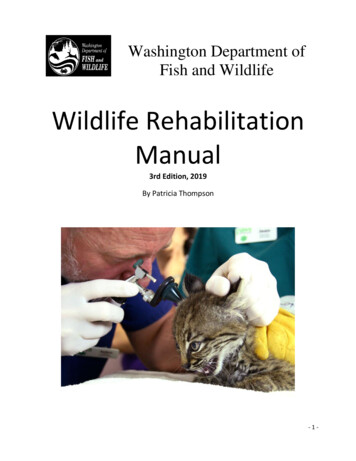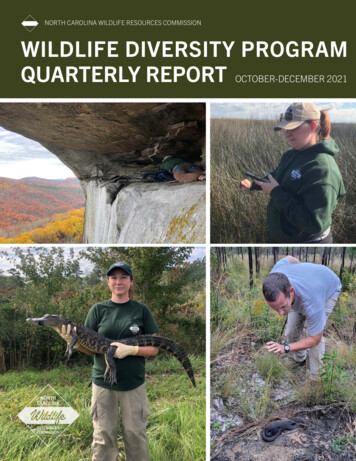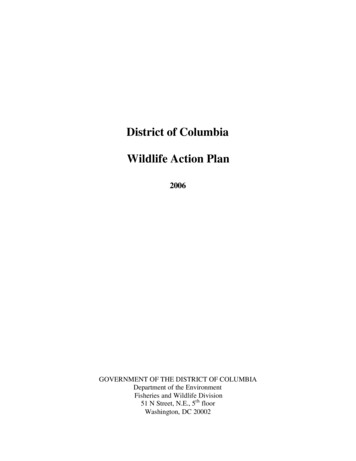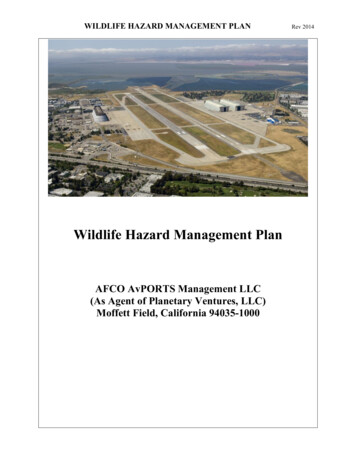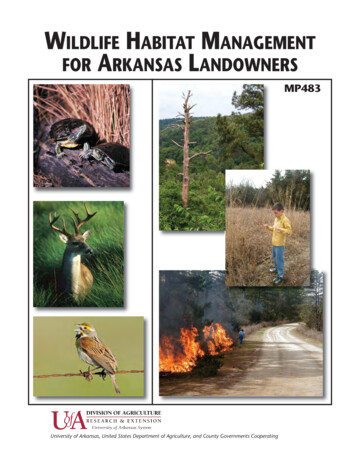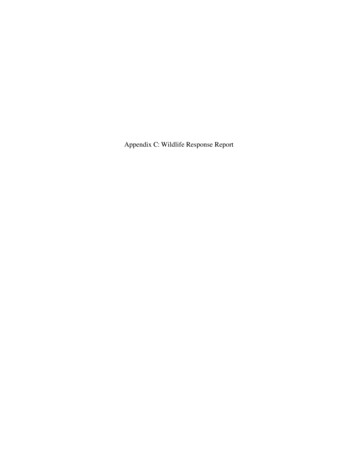
Transcription
Appendix C: Wildlife Response Report
Wildlife Response Activities forthe July 25-26, 2010Enbridge Line 6B Oil Discharges nearMarshall, MIPrepared byScott A. Berg and Lisa L. WilliamsUnited States Fish and Wildlife ServiceEast Lansing Field OfficeApril 7, 2015
Table of ContentsIntroduction and Overview . 3Definitions. 3Incident Command System: Structure and Functions . 5Wildlife Response Activities . 12Wildlife Deterrence . 13Oiled Wildlife Hotline . 14Wildlife Response Center Development . 16Field Teams and Tactics . 18Use of Decoys/Bait at Cannon Net Stations (Waterfowl) . 20Use of Hand-Held Net Deployment Devices (Super Talon) . 21Use of Walk-in Traps (Waterfowl) . 22Use of Alpha-Chloralose on Flighted Geese . 22Hand-feeding Park Geese and Ducks/Hand-capture . 23Use of Leghold Traps (Great Blue Heron and Sandhill Crane) . 23Use of Live Traps (Mammals). 24Turtle Trapping Techniques . 24Volunteers and the Public. 25Wildlife Rehabilitation . 26Wildlife Release . 30Training . 30Branch Management . 31Wildlife Response Chronology . 332
Introduction and OverviewOn Monday, July 26, 2010, Enbridge Energy Partners (Enbridge) reported that a 30-inch pipelinehad ruptured and discharged an estimated 819,000 gallons of crude oil near Marshall, Michigan.Oil discharged from Enbridge’s Lakehead Line 6B on July 25-26, 2010, entered wetlands near therupture and then flowed through Talmadge Creek to the Kalamazoo River, where it continued toflow downstream for approximately 38 miles. Aquatic and floodplain habitats were oiled as werebirds, mammals, turtles and other wildlife.Michigan Department of Natural Resources and Environment (MDNRE) and United States Fish andWildlife Service (USFWS) mobilized on-site and received the first reports of oiled wildlife on July26, 2010. USFWS advised Enbridge to mobilize professional rehabilitators and begin buildingrehabilitation facilities that evening. A wildlife hotline was established that night so that thepublic and responders could report sightings of oiled wildlife. Enbridge mobilized theircontractor, Focus Wildlife, overnight and they then built a complete rehabilitation facility (WildlifeResponse Center or WRC) over the next several days.The USFWS developed and led the Wildlife and Environmental Assessment Branch within theOperations Section of the Incident Command System (ICS), which was used to manage the overallresponse to the oil discharges. This Branch provided technical assistance to U.S. EnvironmentalProtection Agency (USEPA) on natural resource issues and field observations; led reconnaissance,capture, rehabilitation, and release of oiled animals; installed deterrence measures to try tominimize wildlife oiling and road fatalities; and provided a link between natural resource damageassessment (NRDA) field activities and the ICS management of the overall response. The USFWS,MDNRE, U.S. Department of Agriculture (USDA) Animal and Plant Health Inspection Service (APHIS),and contractors employed by USFWS and Enbridge performed daily reconnaissance for oiledwildlife, responded to hotline calls, and captured oiled wildlife when possible on a daily basis untilmid-October of 2010 when responsibility was turned over to Enbridge and their contractors.Enbridge and Focus Wildlife led the rehabilitation functions, with Binder Park Zoo taking a majorrole in rehabilitation of turtles and other reptiles and amphibians. Personnel from additional zoosand volunteers also assisted in animal care and cleaning oiled wildlife. Releases of rehabilitatedanimals were coordinated among USFWS, MDNRE, Enbridge, and contractors.This report describes the operations of the Wildlife and Environmental Assessment Branch fromJuly 26, 2010 through October of 2010.DefinitionsAdministration/Finance – a person(s) responsible for day to day financial and administrativeoperations during the incident.Branch Director – a position within the Incident Command System that has managementresponsibility of the entire branch and oversees all aspects of implementation of the incidentobjectives in the Incident Action Plan that are assigned to the branch. The Branch Director serves3
as the main contact with their respective Section Chief (e.g., Operations) and the IncidentCommander or Unified Command.Enbridge – Enbridge Energy, L.P., Enbridge Pipelines (“Lakehead”) L.L.C., Enbridge Energy Partners,L.P., Enbridge Energy Management, L.L.C., Enbridge Energy Company, Inc. , Enbridge EmployeeServices, Inc., Enbridge Operational Services, Inc., and Enbridge Pipelines Inc.Entrix – a private contractor hired by Enbridge to provide environmental and NRDA expertise.Focus Wildlife – a private contractor hired by Enbridge to provide wildlife operations.GIS Support – a person(s) assigned to provide mapping and geographical spatial data support tofield operations and Incident Command.HRM – Herpetological Resource & Management, a contractor for U.S. Fish and Wildlife Service.IAP – Incident Action Plan, provides a concise, coherent means of capturing and communicatingthe overall incident priorities, objectives, and strategies in the contexts of both operational andsupport activities.ICP – Incident Command Post, a centralized meeting point for Unified Command during theincident. The ICP housed representatives from each responding agency, consistent withmethodology of ICS.ICS – Incident Command System, a standardized on-scene emergency management constructspecifically designed to provide an integrated organizational structure that reflects the complexityand demands of single or multiple incidents, without being hindered by jurisdictional boundaries.ICS is the combination of facilities, equipment, personnel, procedures, and communicationsoperating within a common organizational structure, designed to aid in the management ofresources during incidents. It is used for all kinds of emergencies and is applicable to small aswell as large and complex incidents. ICS is used by various jurisdictions and functional agencies,both public and private, to organize field-level incident management operations.Logistics – a person(s) designated to ensure materials, services and equipment are provided forresponse to the incident.MDNRE – Michigan Department of Natural Resources and Environment.NRDA – Natural Resource Damage Assessment as described in the National Contingency Plan andeither the Comprehensive Environmental Response, Compensation, and Liability Act or the OilPollution Act, as applicable. In this incident, NRDA teams assessed damages to natural resourcesand the service they provide, including collecting ephemeral data in parallel with responseactivities. NRDA field team conducted surveys of impacts to surface water, sediments, soil,vegetation, benthic invertebrates, fish and wildlife and coordinated these field activities throughthe Wildlife/Environmental Damage Assessment Branch.4
Public Information Officer (PIO) – a position within the Incident Command System that managesand disseminates information related to the incident for incident personnel, the public, andmedia.Safety Officer – a position within the Incident Command System, that oversees all aspects of safetyand administers corrective measures in the event of a safety breach within the branch.Stantec – a contractor hired by Enbridge to provide herpetological expertise.Unified Command - In incidents involving multiple jurisdictions, a single jurisdiction with multiagency involvement, or multiple jurisdictions with multi-agency involvement, Unified Commandallows agencies with different legal, geographic, and functional authorities and responsibilities towork together effectively to make decisions to coordinate the response without affectingindividual agency authority, responsibility, or accountability.USDA-APHIS-WS – United States Department of Agriculture Animal and Plant Health InspectionService – Wildlife ServicesUSEPA – United States Environmental Protection Agency.USFWS – United States Fish and Wildlife Service.Wildlife Care – specialized teams in the animal husbandry, veterinary care and rehabilitativeprogress of oiled wildlife. The teams consisted of veterinarians, veterinary assistants, zoologists,rehabilitators and volunteers.Wildlife Recovery – specialized teams in locating, observing and recovering oiled wildlife fortransport to the Wildlife Response Center for rehabilitation. The teams consisted of personnelfrom USFWS, USDA-APHIS-WS, MDNRE, Focus Wildlife, Entrix, HRM, Stantec and volunteers.Wildlife Response Center (WRC) – a facility located in Marshall, Michigan that housed theWildlife/Environmental Damage Assessment Branch. The facility was developed for intake,rehabilitation and conditioning of wildlife. In addition, office space was available for wildliferesponse agencies. This allowed for effective communications and cooperation amongst alldisciplines of the branch.Incident Command System: Structure and FunctionsICS is a pre-determined method of response organization that clearly identifies theresponsibilities, lines of communication and strategies used during any incident. ICS is designedto work across political and physical boundaries, allowing for interoperability during anyemergency situation, regardless of the size.ICS was used from the onset of the Line 6B incident, first led by Enbridge and then by a UnifiedCommand with U.S. EPA serving as the Federal On-scene Coordinator and Incident Commander.5
Personnel from the USFWS Fire Program assisted EPA in establishing ICS and improving its overalleffectiveness, as well as being part of the leadership team for the Wildlife/Environmental DamageAssessment Branch. Within the ICS organizational structure, the Wildlife/Environmental DamageAssessment Branch was placed as one of the branches in Operations:Incident CommandUnified CommandIncident gLogisticsFinanceWildlife/EnvironmentalDamage AssessmentDuring most of the spill response, the Wildlife/Environmental Damage Assessment Branch wasorganized into groups and teams aligned along the following basic structure:Wildlife/Environmental Damage Assessment BranchBranch DirectorSafetyPIOGIS SupportWildlifeRecoveryWildlife CareNRDA - FieldLiaison6LogisticsAdmin/Finance
The Wildlife/Environmental Damage Assessment Branch structure replicates the ICS model and isbroken down into specific groups. These groups, with their descriptions, are as follows:Branch DirectorThe Branch Director position was filled by USFWS personnel from the beginning of the spillthrough September 24, 2010, when USFWS turned over the position to Enbridge. Through most ofthe first three months of the response, the Branch Director was assisted by two Deputy Directors;one from USFWS and one from Enbridge. The Branch Director and Deputies were assignedoversight of all wildlife operations and reported to Unified Command through the OperationsSection.During the height of the response, the Branch Director and Deputies were assisted byDivision/Group Supervisors who worked specifically with the various groups within the Branch.Division/Group Supervisors supported the groups and coordinated completion of ICS planningforms each operational period.SafetyThe Branch Safety Officer developed a Health and Safety Plan specifically for the Branch; did dailysafety briefings; and, monitored working conditions, use of PPE, and waste handling for theWildlife Response Center. Important safety concerns were exposure to oil (including volatilecomponents like benzene), the potential for zoonotic diseases, injuries from wildlife, slip/trip/fallhazards, overheating, dehydration, and electrical hazards (especially around water in tanks,conditioning ponds, and washing areas). The Safety Officer for the Branch provided daily SafetyMessages in accordance with the IAP. The Branch Safety Officer conducted continuous inspectionsof the WRC and took immediate corrective measures on any matters involving unsafe conditions.In addition, the Branch Safety Officer maintained a running log for all watercraft activities (floatplan) and Safe Work Permits (documentation required by Enbridge). The Branch Safety Officer alsohelped develop and provide site-specific Hazardous Waste Operations and Emergency Response(HAZWOPER) training as needed for personnel. As the response continued, the Branch SafetyOfficer also wrote a Fatigue Management Plan for the Branch. No serious incidents were recordedfor the Wildlife Branch.PIOThe USFWS provided a Public Information Officer (PIO) to the Branch to address press releases andother media issues. The PIO was on-site for the first few weeks of the incident and then waslocated off-site for the remainder of the initial response period. The PIO also assisted withcoordinating public meetings and press conferences. Originally press conferences were helddaily, but then were held weekly or less often as the incident progressed.7
GIS SupportMDNRE provided on-site GIS support with specialists and equipment. Mapping needs and otherGIS information were channeled through this position, allowing for fast document turnaroundtime. GIS specialists in the WRC created maps specific to wildlife operations and managed generalsite maps obtained through Unified Command. GIS specialists within the branch suppliedinformation to Unified Command on both the ongoing wildlife response and sensitiveenvironmental areas.Wildlife Recovery GroupInitial field teams and assignments consisted of the following teams and assignments: Terrestrial TeamsoCapture/transport/survey of oiled wildlifeoDevelop alternate strategies and tactics for wildlife captureoMonitor/document locations/conditions where oiled birds (that could fly longdistances) landedo Respond to Oiled Wildlife Hotline calls as neededHerp TeamsoConcentrate on turtle recovery effortsoCoordinate with other branch/division/group operational personnel concerningturtle traps, utilizing ICS 204 (Field Assignment form) information Aquatic TeamsoSurvey, recover and document fish and wildlife impacted in waterways andwetland areasAs the incident progressed, additional field teams were deployed, which consisted of the followingteams and assignments: Focus Terrestrial TeamoRespond to Hotline calls as neededoCapture/transport/patrol of oiled wildlifeoDevelop alternative strategies and tactics for wildlife captureoMonitor/document locations/conditions where oiled birds(that could fly longdistances) landed oDevelop/provide Hazmat training as needed for necessary personneloParticipate in scientific support teamoCoordinate activities using ICS 204 informationFocus Recon TeamoPerform reconnaissanceoCapture/transport/patrol of oiled wildlifeoParticipate in scientific support teamoCoordinate activities using ICS 204 informationBeaver Trapping TeamoPerform reconoCollect oiled animal locationsoDevelop/provide Hazmat training as needed for necessary personnel8
oParticipate in scientific support teamoCoordinate activities using ICS 204 informationoTrap and recover beaver and transport back to the Wildlife Response CenterHeron Capture TeamoCapture/transport/patrol of oiled wildlifeoDevelop alternate strategies and tactics for heron captureoRespond to hotline calls as neededoMonitor/document locations/conditions where oiled heron landoDevelop/provide Hazmat training as needed for necessary personneloParticipate in scientific support teamoCoordinate activities using ICS 204 informationWildlife DataoCollect and process wildlife dataoDevelop/provide Hazmat training as needed for necessary personneloParticipate in scientific support teamoCoordinate activities using ICS 204 informationStantec Herp Team CoordinatoroContinue to concentrate on turtle recovery effortoConfigure personnel into teams and make assignmentsoCoordinate with other branch/division/group operational personnel concerningturtle traps, utilizing ICS 204 informationoDevelop/provide Hazmat training as needed for necessary personneloParticipate in scientific support teamoCoordinate activities using ICS 204 informationIn addition, all teams were directed to conduct a heat stress assessment in accordance with theHealth and Safety Plan for the incident. A strict work/rest schedule was enforced due to high heatand humidity levels during response. Teams also followed a lightning safety protocol forinclement weather.Wildlife Care GroupThe Wildlife Care Group operated primarily in the Wildlife Response Center (WRC), located inMarshall, Michigan. The Wildlife Care Group consisted of the following teams and assignments: Animal Area Intake Crew/Stabilization Area/Response VeterinarianoDocument and photograph animal intakeoConduct initial examination and assessment of animalsoStabilize animals per Focus Wildlife policyAnimal Care Manager/Release CoordinatoroDocument progress of treatment and rehabilitationoOversee medical treatment and follow-up care for animalsoOversee and assist with animal release plansFacilities CoordinatoroEnsure facilities are functioning appropriately for animal intake and rehabilitationoDevelop and maintain intake, holding, cleaning and conditioning areas9
Turtle Area CrewoAssist veterinary staff with all aspects of turtle stabilization, feeding,rehabilitation and preparation for releaseo Develop techniques and methods for safe custody of wintering turtlesAnimal Kitchen CrewoOrganize and maintain animal kitchenoPrepare and record food for varying animal species per veterinary guidelinesCleaning Area CrewoOrganize and maintain cleaning areaoProvide for safe cleaning environment for team members and animalsoClean oiled wildlife by using accepted practices and veterinary guidelinesoMaintain equipment used for cleaning and ensure materials are in stockConditioning Area Crew/Rehab Supervisor/Release CoordinatoroOrganize and maintain conditioning areaoProvide for safe environment for animals to ensure reduced opportunity forescape and/or injury oAssist with conditioning and rehabilitation of animals using veterinary guidelinesoPrepare animals for transport to release locationWildlife Deterrent Task ForceoDevelop wildlife deterrent techniquesoMaintain deterrent devices (fencing, decoys, etc.)oAssist with other tasks as neededAll personnel were required to adhere to the Wildlife Response Center Safety Plan. Crew leadersalso provided task-specific training to crews and volunteers.Natural Resource Damage Assessment (NRDA) – Field LiaisonNRDA teams determined their study priorities separately from ICS, but coordinated their fieldactivities with the rest of the response through an NRDA Field Liaison with theWildlife/Environmental Damage Assessment Branch. The NRDA Field Liaison also ensured that allsafety protocols, permit requirements, and messages from ICS reached the NRDA teams. NRDAteams conducted surveys throughout the response area to evaluate impacts to surface water,sediment, soil, vegetation, benthic invertebrates, fish and wildlife. The NRDA teams reported anyof their sightings of oiled wildlife to the Branch so that dispatchers could direct wildlife responseteams to the indicated locations. In addition, the Branch was able to facilitate the transfer offloodplain oiling survey information from the NRDA teams to the Planning Section.Logistics - Wildlife Support GroupThe Wildlife Support Group operated primarily in the Wildlife Response Center (WRC) and wascomprised of the following: Dispatch/Volunteer CoordinationoProvide radio and telephone communications with field teamsoRelay hotline information for responseoMaintain sign-in sheet for personnel and visitors to the WRC10
o Coordinate and assign volunteers for wildlife operationsEquipment/Supplies StockoEnsure required materials are on-handoWork with local spill donation center and Logistics Section to obtain equipmentand suppliesoDevelop and maintain inventory listAdministration/Finance Administration/PurchasingoProvide for support in ordering materials and equipment for wildlife responseand rehabilitationo Work with Wildlife Support Group to ensure operational readiness of WRCFinanceoEnsure financial requirements for response are metoMonitor daily expenditures to ensure alignment with incident funds allocationoAssist with payrollTechnical Assistance to the U.S. Environmental Protection Agency (EPA)Agency personnel within the Wildlife Branch also provided technical assistance to EPA throughcommunications with Unified Command, Operations Section, and Planning Section: Reviewing and commenting on Enbridge submittalsoOperational Health and Safety PlanoSampling and Analysis Plan and Quality Assurance Project Plano“Remediation” plans for source area and downstream areaso“Restoration” plansScience Team/Environmental Advisory GroupoCleanup recommendationsoSubmerged oiloSeasonal outlookData for removal actions and closure approvalsoObservations of response activities and field conditionsoDiscovery and evaluation of extent of submerged oiloFloodplain survey data from NRDA teamsICS Assistance11Oiled Goose in Flight
Wildlife Response ActivitiesThe mission of the Wildlife/Environmental Damage Assessment Branch was to: Provide protection of environmentally and culturally sensitive areas including wildlifeand historic properties. Protect threatened and endangered species & continue to recover and rehabilitateinjured wildlife.From the early hours of following notification of the oil discharges into the environment, wildliferesponse was a high priority within the overall response.The first USFWS biologist arrived on scene on July 26 and began developing strategies for wildliferesponse. Agency involvement in wildlife reconnaissance and recovery were important for thefollowing reasons: Public and wildlife safetyoLeadership, credibility and visibilityoLocal knowledge and contacts Validation of number and degree of oiled wildlife Independent observations of impacts of oil and response activitiesoSubmerged oiloFenoOther sensitive habitatsoWorker techniquesThe operation of the Branch was under USFWS leadership, but was successful because thecooperation and work contributed by many agencies, contractors, and others, including personnelfrom the following: USFWS MDNRE USDA APHIS Wildlife Services Michigan Department of Agriculture, Emergency Response Unit Stantec HRM Focus Wildlife Binder Park Zoo Manpower VolunteersThe following sections describe wildlife deterrence, oiled wildlife hotline, WRC development, fieldteams and tactics, wildlife rehabilitation, wildlife release, volunteers and the public, training, andBranch management12
Wildlife DeterrenceEfforts to prevent un-oiled wildlife from becoming oiled were implemented in the early days of thespill. Deterrence crews worked on foot to construct barriers to prevent animals from entering theriver. Additional deterrence strategies included: Silt Fencing Snow Fencing Scare Tape Propane Cannons Predator “Scarecrows” Response Worko 1,500 workersoFlotillas of airboatsoHelicoptersoVacuum trucksCoyote “Scarecrow” DecoyDeterrence Fencing and Scarecrow13
Deterrence fencing was also placed along a road that was being heavily used by response vehiclesin order to reduce the risk to turtles after a spotted turtle was found in the area. The spottedturtle is listed by the State of Michigan as a threatened species.Oiled Wildlife HotlineEnbridge developed and maintained an Oiled Wildlife Hotline that provided a single-sourcereporting location for members of the community and spill responders. The reports of oiledwildlife were forwarded to the Wildlife Response Center for dispatch, which allowed for timelyresponse by wildlife field crews.The hotline number was advertised continually, using a variety of approaches: Press conferences Press releases IAPs Flyers/Leaflets Business Cards Magnetic Door Shields Websites Wildlife Trapping Notice Signs14
Wildlife Hotline Calls by SpeciesSnakes 13Toad 1DucksUnk 1GeeseDucks 64SwansHeronTurtles 70BirdsFrogs 6PigeonsCrayfish 1Skunk 1Fish 10Sandhill CraneRaccoon 11TurkeysOpossum 2CormorantsMuskrat 16Otter 1GullsMouse 1Deer 3Geese 154DoveBeaver 9Dove 1Gulls 1Cormorants 1Turkeys 1BeaverSandhillCrane 5Pigeons 1 Heron 11Birds 10DeerMouseSwans 1015
The majority of wildlife hotline calls were reports of oiled geese, turtles and ducks. Other wildlifespecies were also reported but with less frequency. Additionally, the hotline was used moreduring the first week of the spill response. Its use diminished as the incident progressed withtime.Enbridge Spille Line 6BOiled Wildlife Hotline Calls60Number of Calls504030Total20Expon. 0Number of Hotline Calls by DateWaterproof business cards with the Oiled Wildlife Hotline number on its face were provided towildlife field crews and were distributed during face to face contacts with local residents and spillresponders. Several reports came in to the WRC as a result of the cards, many of which weregenerated by spill responders. Additionally, magnetic door shields that displayed the hotlinenumber were provided for use on wildlife recovery vehicles. This allowed for high visibility ofteams when on the road and afield and also identified responders as incident staff when stoppedalong roadways and near private residences.In addition, the hotline was used for general information about the oil spill. Volunteers could usethe hotline to sign up to assist at the spill. General wildlife questions could also be asked.Wildlife Response Center DevelopmentOn Day 2 of the response, Focus Wildlife personnel arrived on-scene and began establishing theWildlife Response Center (WRC). Enbridge and Focus Wildlife identified a facility previously usedby the Firekeepers Casino in Marshall, Michigan, as having characteristics that met wildliferecovery needs. The building included office space for responding agencies and organizationsand eventually was equipped with telephones and internet access. A conference room was alsoavailable and was used for daily briefings and meetings. Adequate floor space for wildlife intake,rehabilitation and conditioning allowed for flexibility in use and design. The physical structure16
within the building changed frequently to address the needs of wildlife care. A large parking areaon-site allowed for convenient parking of personnel and response equipment. In addition, a largeconditioning facility, complete with water pools, filtration and secure housing, was establishedclose to the main building, yet far enough from the main parking lot to minimize disturbances torecovering wildlife by vehicles and other equipment. Storage was available in two large seacontainers. A large, unattached garage provided additional conditioning and storage areas.Focus Wildlife and Enbridge built systems for water supply, handling and disposal on-site and hadto make adjustments to heating, cooling, and electrical systems to provide proper climate controlfor recovering wildlife. To get sufficient water volume and pressure, they worked with localauthorities to use nearby fire hydrants to supplement the water supply to the facility. Theyinstalled on-demand water heaters and pressure controllers to provide a reliable supply of waterat the narrow range of temperature and pressure required for washing large numbers of oiledanimals. They also installed several large holding tanks for waste water and arranged for vacuumtrucks from the overall incident response to empty them as needed.Wildlife Response CenterConditioning pen area17
Wastewater tanks
transport to the Wildlife Response Center for rehabilitation. The teams consisted of personnel from USFWS, USDA-APHIS-WS, MDNRE, Focus Wildlife, Entrix, HRM, Stantec and volunteers. Wildlife Response Center (WRC) - a facility located in Marshall, Michigan that housed the Wildlife/Environmental Damage Assessment Branch.

